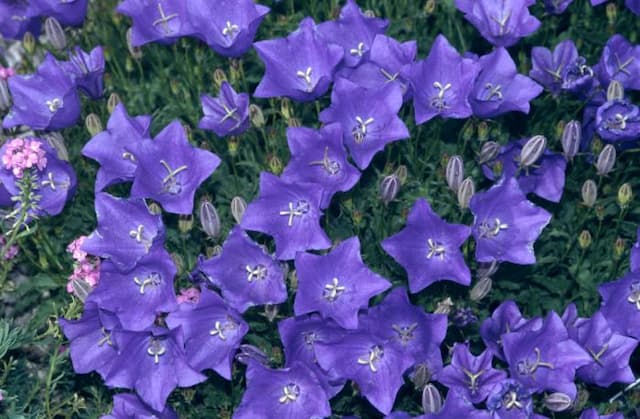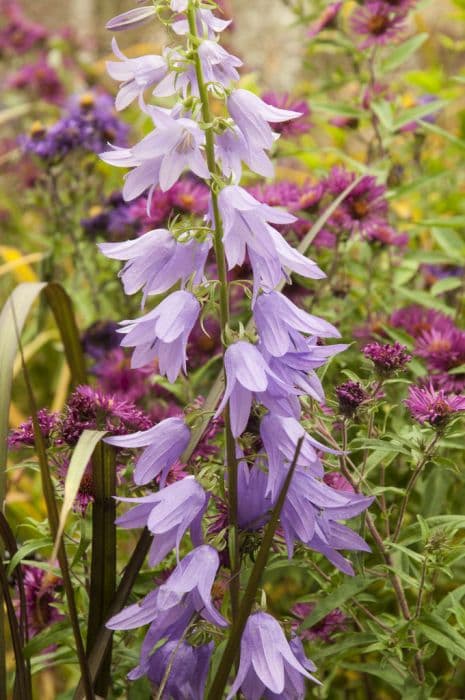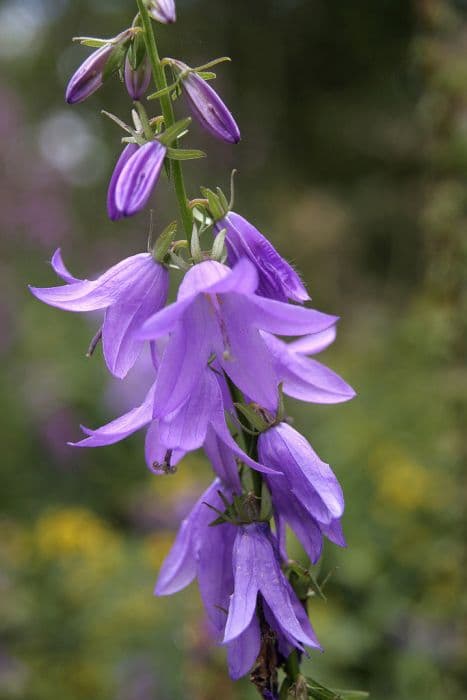Clustered Bellflower Campanula glomerata 'Superba'

ABOUT
The Campanula glomerata 'Superba', more commonly known as clustered bellflower, is a perennial flower known for its vibrant and showy blooms. This plant produces a lush mound of foliage at its base, from which arises a profusion of upright stems clad in narrow, lance-shaped leaves that are medium green in color. The clustered bellflower is best admired for its flowers, which are the star attraction. The blooms gather together in dense clusters at the stem tips, creating a bold display. Each individual flower is shaped like a small bell or cup, which is typical for the bellflower family. The petals are a rich violet-blue hue, exuding a sense of regality and depth of color. The clustered bellflower's blooms come together at the top of the stems, giving the impression of a rounded bouquet, hence the name 'Superba'—implying a superb or superior floral show. The vibrant color is a magnet for pollinators such as bees and butterflies, adding to the plant's charm and ecological value in a garden setting. This plant typically blooms in the early to mid-summer, with the flowering period continuing for several weeks. The clustered bellflower makes an excellent addition to borders, cottage gardens, or as a part of a naturalized area, providing a pop of color and visual interest without the details of its size playing a crucial role in its garden placement.
About this plant
 Names
NamesFamily
Campanulaceae
Synonyms
Clustered Bellflower, Dane's Blood
Common names
Campanula glomerata var. acaulis, Campanula glomerata var. dahurica, Campanula dahurica.
 Toxicity
ToxicityTo humans
Clustered bellflower, which is the most common name for Campanula glomerata 'Superba', is not known to be toxic to humans. There are no well-documented cases of poisoning from ingesting this plant. Therefore, it is not considered a hazard for human health in terms of toxicity.
To pets
Clustered bellflower is also not known to be toxic to pets. It does not contain any known toxins that would pose a threat to dogs, cats, or other domestic animals if ingested. Consequently, there are no specific symptoms of poisoning associated with this plant for pets, and ingestion should not lead to any significant consequences.
 Characteristics
CharacteristicsLife cycle
Perennials
Foliage type
Deciduous
Color of leaves
Green
Flower color
Violet
Height
1-2 feet (30-60 cm)
Spread
1-2 feet (30-60 cm)
Plant type
Herb
Hardiness zones
3-8
Native area
Europe
Benefits
 General Benefits
General Benefits- Attracts pollinators: Campanula glomerata 'Superba' is known to attract bees, butterflies, and other beneficial pollinators to the garden, supporting biodiversity.
- Easy to grow: This plant is generally hardy and adapts well to a variety of soil conditions, making it a good choice for novice gardeners.
- Ornamental appeal: With its striking blue-violet flowers, it adds color and visual interest to garden borders, rock gardens, or as a ground cover.
- Long blooming period: It has a long flowering season from late spring to early summer, providing continuous blooms during this period.
- Drought-tolerant: Once established, Campanula glomerata 'Superba' can tolerate periods of drought, reducing the need for frequent watering.
- Cold-hardy: It can survive in cold climates and is capable of withstanding freezing temperatures, making it suitable for northern gardens.
- Low maintenance: Requires minimal care once established, with little need for fertilizing or pruning, saving time and effort for gardeners.
 Medical Properties
Medical Properties- This plant is not used for medical purposes.
 Air-purifying Qualities
Air-purifying QualitiesThis plant is not specifically known for air purifying qualities.
 Other Uses
Other Uses- As a natural dye: The flowers of the Clustered Bellflower can be used to create a natural dye for fabrics, providing shades of blue or purple depending on the mordant used.
- Ikebana (Japanese flower arranging): The striking shape and color of the Clustered Bellflower make it an attractive choice for the traditional art of Japanese floral arrangements.
- Edible decoration: The petals of the Clustered Bellflower are edible and can be used to add color and a mild flavor to salads and desserts.
- Photography subject: Due to its vibrant color and distinctive shape, the Clustered Bellflower is a popular subject for photographers, especially in macro photography.
- Garden border stabilization: The dense growth habit of the Clustered Bellflower can help to prevent soil erosion in garden beds and borders.
- Educational tool: The plant can be used in educational settings to teach about pollination and the role of native flora in supporting local wildlife.
- Craft projects: Dried Clustered Bellflower blooms can be incorporated into craft projects, such as pressed flower art or homemade potpourri.
- Theme gardens: Clustered Bellflower can be used in fairy or miniature gardens due to its enchanting appearance and manageable size.
- Bee garden addition: The flowers are attractive to bees, making them a beneficial addition to gardens designed to support pollinators.
- Companion planting: Clustered Bellflower can be used in companion planting to attract beneficial insects that may help control pest populations in the garden.
Interesting Facts
 Feng Shui
Feng ShuiThe Clustered Bellflower is not used in Feng Shui practice.
 Zodiac Sign Compitability
Zodiac Sign CompitabilityThe Clustered Bellflower is not used in astrology practice.
 Plant Symbolism
Plant Symbolism- Gratitude - Campanula, commonly known as Clustered Bellflower, often symbolizes gratitude due to its bell-shaped flowers that seem to pour out their beauty generously, akin to the manner in which we express thanks.
- Constancy and Perseverance - The robust nature of the Clustered Bellflower with its ability to thrive in a variety of conditions represents steadfastness and the ability to endure through challenges.
- Humility - Its drooping bell-shaped flowers evoke a sense of modesty and humility, reminding us of the virtue of being humble despite our abilities or achievements.
- Vulnerability - The delicate structure and open form of the Clustered Bellflower's blooms can symbolize openness to the world and the acceptance of vulnerability.
- Unwavering Love - In the language of flowers, campanulas in general are sometimes associated with undying love, and the hardy nature of the Clustered Bellflower amplifies this message of everlasting affection.
 Water
WaterClustered Bellflower, or Campanula glomerata 'Superba', prefers evenly moist soil, so water it thoroughly when the top inch of soil feels dry to the touch. This usually means watering once a week, but the frequency may need to increase during very hot or dry spells. Aim to provide about one inch of water, which equates to roughly 0.6 gallons per square yard, each time you water. Ensure water penetrates deeply into the soil rather than just wetting the surface, as this encourages deep root growth. During the winter months, reduce watering as the plant's growth slows down.
 Light
LightThe Clustered Bellflower thrives in areas with full sun to partial shade. It performs best when it receives at least 6 hours of sunlight per day. An ideal spot for this plant would be one that gets morning sunlight and some afternoon shade, especially in regions with intense midday heat. However, it can also handle full sun locations as long as the soil moisture is maintained.
 Temperature
TemperatureThe Clustered Bellflower can tolerate a wide range of temperatures but performs best between 60°F and 75°F. This plant can survive minimum temperatures down to about 20°F and can handle summer highs up to around 85°F. It is hardy and can survive winter chill, but in very hot climates, it may benefit from some afternoon shade to prevent overheating.
 Pruning
PruningThe Clustered Bellflower should be pruned to remove spent flowers and encourage a second bloom. Pruning should be done after the first flush of flowers has faded, typically in mid to late summer. Additionally, trimming back the foliage in late fall helps maintain a tidy appearance and can reduce the likelihood of disease. Regular deadheading of spent flowers will also promote further blooming throughout the season.
 Cleaning
CleaningAs needed
 Soil
SoilClustered Bellflower thrives best in well-draining soil rich in organic matter with a pH range of 6.0 to 8.0. A mixture of loam, compost, and coarse sand is ideal to maintain proper moisture and nutrients.
 Repotting
RepottingClustered Bellflower does not generally require frequent repotting and can be done every 2-3 years to refresh the soil or to divide the plant when it becomes too crowded.
 Humidity & Misting
Humidity & MistingClustered Bellflower prefers moderate humidity levels but is quite adaptable and can tolerate the humidity levels commonly found in most outdoor environments.
 Suitable locations
Suitable locationsIndoor
Place in bright, indirect light and ensure good ventilation.
Outdoor
Plant in partial shade, enrich soil, water regularly.
Hardiness zone
3-8 USDA
 Life cycle
Life cycleCampanula glomerata 'Superba', commonly known as Clustered Bellflower, begins its life cycle when the seeds germinate in early spring, given moist soil and cool temperatures. The seedlings develop into a rosette of basal leaves, establishing a strong root system. As the plant matures, upright stems grow from the rosette and bear dense clusters of violet-blue, bell-shaped flowers by late spring to early summer. After pollination by bees and other insects, the flowers produce small capsule-like fruits containing numerous seeds. The plant then enters a period of dormancy in the winter, where above-ground growth dies back, and it survives as underground rhizomes or as a basal rosette in milder climates. The life cycle continues in the following spring when new growth emerges from the surviving rootstock or new seedlings germinate.
 Propogation
PropogationPropogation time
Spring-Early Summer
The most popular method of propagating Clustered Bellflower, which is the common name for Campanula glomerata 'Superba', is by division. Usually, gardeners perform this method in spring or autumn when the plant is not in active bloom. To propagate by division, you carefully dig up the plant, ensuring you have a good amount of roots, and then gently separate the plant into smaller sections, each with its own root system. These divisions can then be replanted into well-draining soil, spaced at least 12 inches (about 30 centimeters) apart to allow for ample growth. It's important to water these new plants regularly until they are established and starting to grow on their own.









